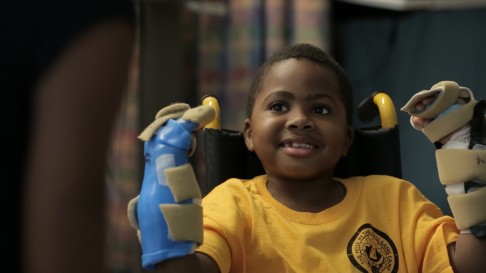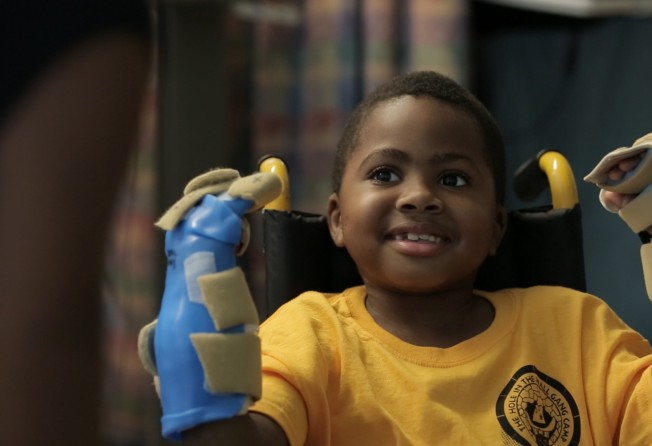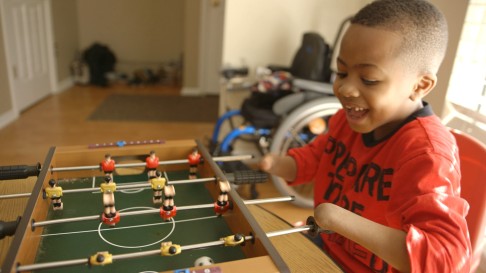
Boy, 8, has world's first child double hand transplant
Zion Harvey, who had his hands and feet amputated at a young age, received donor hands and forearms in a 10-hour operation in the US; his doctors performed same surgery on adult in 2011


Zion Harvey, who had his hands and feet amputated due to a severe infection as a young boy, has always dreamt of throwing a football. It looks like his wish will finally come true.
Zion, eight, was the recipient of the world’s first bilateral hand transplant on a child earlier this month. A 40-member multidisciplinary medical team from The Children's Hospital of Philadelphia (CHOP) and Penn Medicine successfully transplanted donor hands and forearms onto Zion after a 10-hour operation.
"This surgery was the result of years of training, followed by months of planning and preparation by a remarkable team," says Dr Scott Levin, chairman of the Department of Orthopaedic Surgery at Penn Medicine and director of the Hand Transplantation Programme at The Children's Hospital of Philadelphia, who led the team.
"The success of Penn's first bilateral hand transplant on an adult, performed in 2011, gave us a foundation to adapt the intricate techniques and coordinated plans required to perform this type of complex procedure on a child."
A happy and outgoing child, Zion adapted well to life without hands, learning to eat, write and even play video games. He figured out ways to perform most of the activities other kids his age can do. Zion received prosthetics for his feet and is able to walk, run and jump with complete independence.
A suitable hand and forearm donor was found through the Gift of Life Donor Programme, a non-profit organ and tissue donor programme which partners transplant centres in the eastern half of Pennsylvania, southern New Jersey and Delaware.
During the surgery, the hands and forearms from the donor were attached by connecting bone, blood vessels, nerves, muscles, tendons and skin.
The surgical team – consisting of physicians, nurses and other staff from plastic and reconstructive surgery, orthopaedic surgery, anesthesiology, and radiology – was divided into four simultaneous operating teams, two focused on the donor limbs, and two focused on the recipient.
First, the forearm bones, the radius and ulna, were connected with steel plates and screws. Next, microvascular surgical techniques were used to connect the arteries and veins. Once blood flow was established through the reconnected blood vessels, surgeons individually repaired and rejoined each muscle and tendon. Surgeons then reattached nerves and then closed the surgical sites.

"The skills necessary to perform such complex surgery at CHOP have been acquired from lessons learned over the past 20-plus years of performing pediatric solid organ transplantation," says Dr Abraham Shaked, the Eldridge L. Eliason Professor of Surgery and Director, Penn Transplant Institute.
"We have learned the importance of closely monitoring and managing the activity of the immune system through years of experience, and are hopeful that Zion will enjoy excellent long-term allograft function and a normal life."
Double hand transplantation is a complex procedure involving many surgical and non-surgical components. First, the potential recipient must undergo extensive medical screenings and evaluations before surgery. Zion’s previous medical condition, following sepsis at an early age which resulted in the amputations and a kidney transplant, factored into the decision to perform the transplant.
"Zion's kidney transplant following his infection made him a candidate for transplant because he was already taking anti-rejection medication," says Benjamin Chang, co-director of CHOP's Hand Transplant Programme as well as associate chief of the Division of Plastic Surgery at Penn Medicine.
Zion continues to receive daily immunosuppressant medications to prevent his body from rejecting the new limbs, as well as his transplanted kidney. He undergoes rigorous hand therapy several times a day at CHOP’s rehabilitation unit to gain improvement in function.
The clinical team expects Zion to spend several more weeks in rehab, and then to be discharged to his home in Baltimore, Maryland. Levin and his team will continue to follow Zion monthly in the short-term and then annually throughout his lifetime.